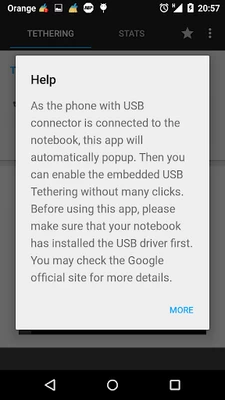
USB Tethering
- 5.0 RATINGS
- 38.00MB DOWNLOADS
- 4+ AGE
About this app
-
Name USB Tethering
-
Category UTILITIES
-
Price Free
-
Safety 100% Safe
-
Version -tethering
-
Update Dec 05,2024



USB Tethering is an app that has become a crucial tool in modern mobile devices, enabling users to share their mobile internet connection with other devices. This functionality allows, for instance, a smartphone to share its mobile data with a laptop, tablet, or any other compatible device. By leveraging USB Tethering, users can maintain an internet connection on their computers even in the absence of Wi-Fi or hotspot signals, making it particularly useful for mobile work and travel scenarios.
The core principle behind USB Tethering involves using a USB cable to connect a mobile device to a computer, effectively turning the mobile device into a wireless modem. This setup enables the computer to access the internet through the mobile device's data connection. Notably, USB Tethering is supported by various operating systems, including the latest versions of Android, and can be easily activated through specific settings or third-party apps.
In the context of Android development, USB Tethering can be implemented through the use of the ConnectivityManager class. Developers can programmatically control this feature by calling the startTethering method, which requires specific permissions to be declared in the AndroidManifest.xml file. These permissions include CHANGE_NETWORK_STATE, ACCESS_NETWORK_STATE, WRITE_SETTINGS, ACCESS_WIFI_STATE, CHANGE_WIFI_STATE, and TETHER_PRIVILEGED. Once these permissions are in place, the app can check for tethering support, acquire a ConnectivityManager instance, and initiate the tethering process.
To activate USB Tethering on an Android device, users typically need to connect their device to a computer via USB and enable the tethering option in the device's settings. In some cases, advanced users or developers may opt to use the Android Debug Bridge (ADB) to enable USB Tethering through commands like "adb shell android-gadget-service enable rndis." This command activates the Remote Network Driver Interface Specification (RNDIS) mode, allowing the computer to recognize the Android device as a network adapter.
USB Tethering apps often come with intuitive interfaces that make it easy for users to start and stop the tethering process. Some apps, such as USB Tethering Duck or similar tools, automatically detect when a USB device is connected and prompt users to start sharing the internet connection. These apps are tested across various Android versions, ensuring compatibility and reliability.
It's worth noting that while USB Tethering is a powerful feature, it does come with some considerations. First, not all Android devices support tethering due to hardware or carrier restrictions. Second, enabling tethering can impact mobile data usage, so it's advisable to use this feature with the user's consent. Additionally, users should be aware of any potential data caps or additional charges that may apply when using mobile data for tethering.
In conclusion, USB Tethering apps provide a convenient way to share internet connections between mobile devices and computers. Whether for work, travel, or emergency situations, these apps offer a reliable and efficient solution to stay connected. With the right permissions and settings in place, developers and users can easily leverage USB Tethering to enhance their mobile computing experience.














